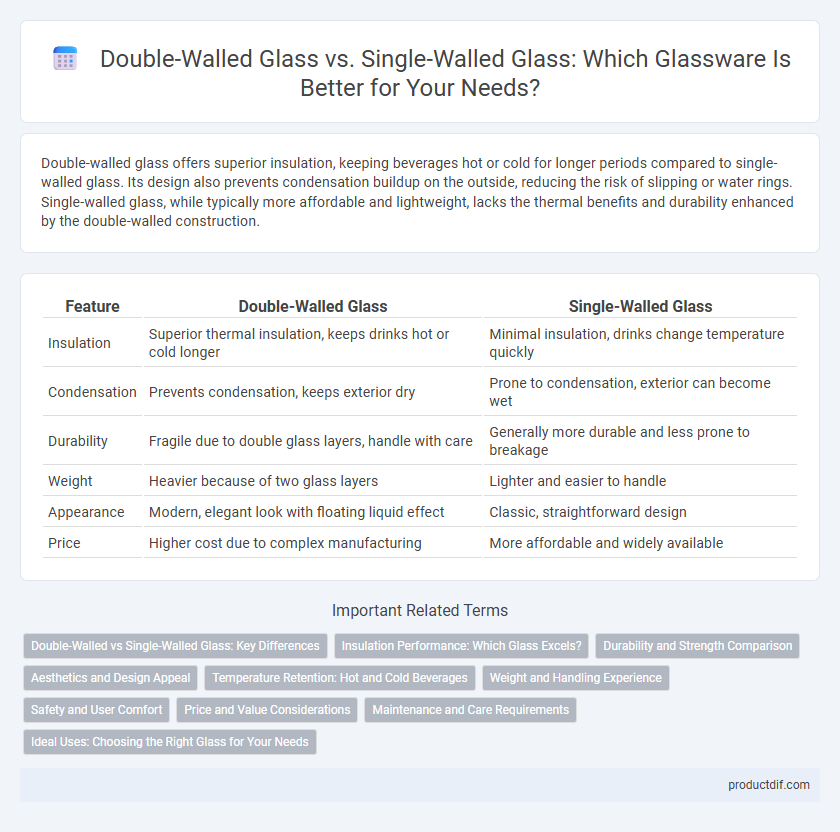Double-walled glass offers superior insulation, keeping beverages hot or cold for longer periods compared to single-walled glass. Its design also prevents condensation buildup on the outside, reducing the risk of slipping or water rings. Single-walled glass, while typically more affordable and lightweight, lacks the thermal benefits and durability enhanced by the double-walled construction.
Table of Comparison
| Feature | Double-Walled Glass | Single-Walled Glass |
|---|---|---|
| Insulation | Superior thermal insulation, keeps drinks hot or cold longer | Minimal insulation, drinks change temperature quickly |
| Condensation | Prevents condensation, keeps exterior dry | Prone to condensation, exterior can become wet |
| Durability | Fragile due to double glass layers, handle with care | Generally more durable and less prone to breakage |
| Weight | Heavier because of two glass layers | Lighter and easier to handle |
| Appearance | Modern, elegant look with floating liquid effect | Classic, straightforward design |
| Price | Higher cost due to complex manufacturing | More affordable and widely available |
Double-Walled vs Single-Walled Glass: Key Differences
Double-walled glass features two layers of glass with an insulating air space between them, significantly reducing heat transfer and preventing condensation compared to single-walled glass. Single-walled glass consists of a single layer, which leads to faster temperature changes and increases the risk of burns or cold condensation on the surface. The insulating properties of double-walled glass make it ideal for maintaining beverage temperature and enhancing durability in glassware.
Insulation Performance: Which Glass Excels?
Double-walled glass excels in insulation performance by providing an air or vacuum layer between two glass walls, significantly reducing heat transfer compared to single-walled glass. This design maintains beverage temperature for extended periods, whether hot or cold, while preventing condensation on the exterior surface. Single-walled glass lacks this insulating barrier, leading to faster temperature loss and increased risk of burns or condensation.
Durability and Strength Comparison
Double-walled glass offers superior durability compared to single-walled glass due to its dual-layer construction, which provides enhanced resistance to thermal stress and impact. Single-walled glass is more prone to cracking or breaking under sudden temperature changes or physical pressure. The air gap in double-walled glass acts as an insulating buffer, reducing the likelihood of damage and extending the glassware's overall lifespan.
Aesthetics and Design Appeal
Double-walled glassware offers a sleek, modern design with the illusion of a floating liquid, enhancing visual appeal and sophistication. Single-walled glassware provides a traditional, minimalist look that emphasizes clarity and simplicity. The dual layers in double-walled glasses create an artistic contrast, making beverages visually striking while maintaining temperature insulation.
Temperature Retention: Hot and Cold Beverages
Double-walled glass offers superior temperature retention for both hot and cold beverages due to its insulating air gap, minimizing heat transfer and condensation. Single-walled glass lacks this insulation, causing liquids to cool or warm faster and making the glass surface uncomfortable to hold. For prolonged enjoyment of coffee, tea, or iced drinks, double-walled glass provides a more consistent temperature and user-friendly experience.
Weight and Handling Experience
Double-walled glassware offers superior insulation with a lightweight design, enhancing comfort during extended use without feeling heavy or cumbersome. Single-walled glass tends to be heavier, making handling less effortless, especially when hot or cold beverages are involved. The double-wall construction provides a more stable grip and prevents heat transfer, improving overall user experience.
Safety and User Comfort
Double-walled glass offers enhanced safety by maintaining exterior surface cool to the touch, reducing burn risks compared to single-walled glass. Its insulating properties prevent condensation, ensuring a secure grip and preventing slippage during use. User comfort improves through superior heat retention, keeping beverages at desired temperatures longer without discomfort.
Price and Value Considerations
Double-walled glassware typically commands a higher price due to its insulated design that prevents heat transfer and enhances durability, offering better value for those seeking temperature retention and reduced condensation. Single-walled glass is generally more affordable but lacks the insulating properties, making it less suitable for hot or cold beverages over extended periods. Investing in double-walled glass provides long-term benefits despite the upfront cost, delivering superior performance and user experience.
Maintenance and Care Requirements
Double-walled glass offers superior insulation, reducing condensation and minimizing the need for frequent cleaning compared to single-walled glass. Its construction requires gentle hand washing to prevent damage to the delicate inner layer, whereas single-walled glass tends to be more durable and dishwasher-safe. Proper maintenance of double-walled glass ensures long-lasting clarity and performance, preserving its thermal benefits and aesthetic appeal.
Ideal Uses: Choosing the Right Glass for Your Needs
Double-walled glassware offers superior insulation, making it ideal for maintaining the temperature of hot or cold beverages, perfect for coffee, tea, and iced drinks. Single-walled glass is better suited for everyday use where insulation is less critical, such as serving water or juice. Selecting the right glass depends on whether temperature retention or simplicity and affordability are the priority.
Double-Walled Glass vs Single-Walled Glass Infographic

 productdif.com
productdif.com